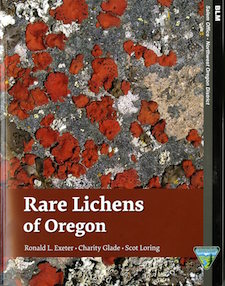Rare Lichens of Oregon
Last Updated on November 21, 2022 by

by Exeter Ronald L., Charity Glade and Scot Loring
ISBN 13:978-0-9791310-6-6 and ISBN 10:0-979-1310-6-5
Salem District Bureau of Land Management, Salem Oregon, 2016
Rare Lichens of Oregon provides species specific information on 78 special status lichen species included in the 2016 publication Rare, Threatened and Endangered Species of Oregon by the Oregon Biodiversity Information Center (ORBIC). Rare Lichens of Oregon covers each species including synonyms, common names, field summaries, diagnostic characters, detailed descriptions, ecology, similar species, and distribution, including distribution maps by counties. The book is lavishly illustrated with over 290 photos and drawings. The use of the latest ORBIC rare species list ensures that the taxa in the book are currently of conservation concern and that the taxonomy is current, including one newly described species (Leptogium compactum). The book comes with a CD that includes both high and low resolution pdf files so the publication can be loaded on a computer or mobile device for greater flexibility.
A BLM botanist with 35 years of experience, Ron Exeter has coauthored several valuable field guides for agency botanists and others who need or want to know rare nonvascular species, from fungi to mosses, liverworts, and lichens. Ron delights in the small stuff. His coauthors, Charity Glade and Scot Loring, share his passion.
I was drawn to this book because I also love the small stuff, especially the colorful world of lichens. In one of my past lives, I conducted lichen surveys for a living. Currently, I am an ecologist with the US Forest Service and it is part of my job to understand the ecology and habitat requirements for sensitive, threatened and endangered plant species, both vascular and nonvascular.
A handy table following the introduction shows the ecoregions where one is likely to find the species covered in Rare Lichens of Oregon. The authors did not indicate if the table also shows ecoregions where species are suspected to occur, but I’m fairly certain that species are shown only for the ecoregions where they have been documented. The main body of the book consists of descriptions of 58 macrolichens followed by 21 microlichens.
The clarity and exquisite detail in the photographs are exactly what is needed to illustrate the micro and macro diagnostic characters of each species. Where needed, photographs are supplemented by illustrations. The microlichens include photos of spores and other micro-characteristics, with clear scale bars beside some of them. The photographs would be more useful if reference scales were consistently included (many images lack a scale indicator). A brief description of ecology, distribution and similar species, is followed by a list of abbreviated references. The full citations for the references are given in the References section at the end of the book.
This book is not geared to lichen novices. There are no keys and no guidance on how to identify lichens. The authors state in the introduction, that they “choose to defer a detailed lichen introduction to other available resources, and recommend Macrolichens of the Pacific Northwest, 2nd edition, by Bruce McCune and Linda Geiser.” The description for each taxon lists three to five diagnostic characteristics useful for confirming one’s identification using McCune and Geiser’s key.
At 8½ x 11”, this is a rather large book to take in the field, and without keys it is more appropriate as a desk reference. I recommend this book to serious (experienced) lichen enthusiasts; anyone else will need to invest in the guides recommended in the introduction, and learn how to use them. This guide is like a conversation with an expert in the field, where you need to be willing to actively participate and fill in the background to make it worth your while.
—Jenifer Ferriel, William Cusick Chapter.
